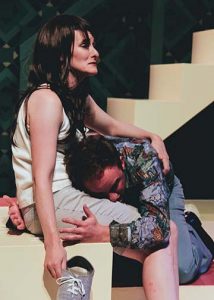When they launched the Cutting Ball Theater in San Francisco’s Tenderloin District back in 1999, Rob Melrose and Paige Rogers weren’t shy about announcing what they were up to—the couple’s plan focused on “taking audiences to places that they don’t normally go.”
After nearly two decades—16 years with Melrose at the helm, another 3 with Rogers running the show—the company has gone all those places, and taken a loyal band of subscribers with them. They’ve got a shelf of awards for artistic achievement and working relationships with like-minded artists from around the world. Now it’s time, say Melrose and Rogers, to pass the torch: On June 1, the company’s leadership will be assumed by Ariel Craft, an award-winning 28-year-old Bay Area director who has honed her own reputation with such well-received Cutting Ball productions as The Mineola Twins and Phaedra.
JIM O’QUINN: Characterize Cutting Ball for me. What is it about the company that brought you there to work?
ARIEL CRAFT: Cutting Ball is a very tricky company to characterize—it specifically champions risk in whatever form that the core artists working there feel is important. It really encourages its artists to radicalize form and to push the outer limits of what we know works theatrically, so we can hit new frontiers and find new things that work onstage. There’s no premium placed on conventionality. It’s a process-focused theatre with the belief that if you put emphasis on process, your product will be something worth having.
Have you found San Francisco audiences ready for that?
Yeah, absolutely. We’re about to have our 20th season next year, and this has been a journey of audience cultivation—learning how you develop a stable of people who want to be challenged, and come to the theatre to see something that they don’t ordinarily expect to see. Our audiences come to be surprised, to seek new experience, and they’re unfazed by something that doesn’t entirely cognitively compute or follow a formula they’re used to.
And they’re not fazed either by plunging right into the Tenderloin, which is where the doors of the theatre open?
Well, that’s an important part of our identity—we value our Tenderloin community, and recently our company has made strides in building meaningful bonds there. We have an education program specifically designed for Tenderloin youth; we have initiatives reaching out to bring residents of the Tenderloin into our theatre and make them part of our community.
San Francisco is a city in flux right now, and you can feel the fracture in the Tenderloin more than you can most places in the city. It’s one of the last areas of the city to gentrify, but it is happening. And, of course, we’ve been there long before gentrification began. I live a few blocks from the theatre, and alongside a really significant population of people who are living on the street and people who are having mental health crises, there’s a place that sells $12 toast! You can see the collision happening in a really significant way.

Rob and Paige must be an inspiration to you. How did your relationship with them develop?
I have known Rob and Paige since I was 15 years old—Rob was actually my high school teacher. You could say that I grew up in the Cutting Ball way: Cutting Ball shows were some of the first shows I ever saw and engaged with in a meaningful way. That has been very formative. It means my education is pervaded by the values that are intrinsic to Cutting Ball, meaning trying things and not knowing if they would work, seeking the less obvious, and using the theatre as the space to communicate and explore.
How do you think Cutting Ball will be different with you at the helm, and how will it be the same?
That’s a great question. What will remain consistent is that this will continue to be a place where you come to see experimentation, where you come to see someone pushing the boundaries of form, where things you haven’t seen before might be happening—you’re not going to see what you see at Cutting Ball in any of the other theatres in San Francisco, I think. How will it be different? Well, it will be my personal curiosities that are leading the charge.
What directions might your personal curiosity take the company? Any clues?
Certainly that will continue to change as I change as a person, but right now I am particularly interested in exploring fluidity in form and fluidity in collaboration. The two tent poles of Cutting Ball’s recent agenda have been re-envisioned classics and new works, and as an artist I’m interested in the collision between those two parts of our canon, and what happens when something is neither staunchly a re-envisioned classic nor staunchly a brand new work.
Will Rob and Paige come back and participate?
Yes, they will remain on our board, and it’s safe to say they’ll continue to be very active participants in the theatre. We already know that next season Paige will be directing something. Essentially, Cutting Ball began as a family business—it runs on a deep feeling of trust. Rob and Paige often say the company is their third child, though, of course, chronologically it was their first, because it predated their two children.
I’ve been working at Cutting Ball for three years as the associate artistic director. This is a profoundly internal transition. Cutting Ball is already a leader, as I said earlier, in exploring fluidity in theatrical form and fluidity of collaboration for artists, and that’s work I want to continue. I want every artist to feel that they leave meaningful fingerprints on a piece, and that their artistry is key to the final project onstage, no matter what their creative role in the show may be.
Jim O’Quinn is the founding editor of this magazine.





